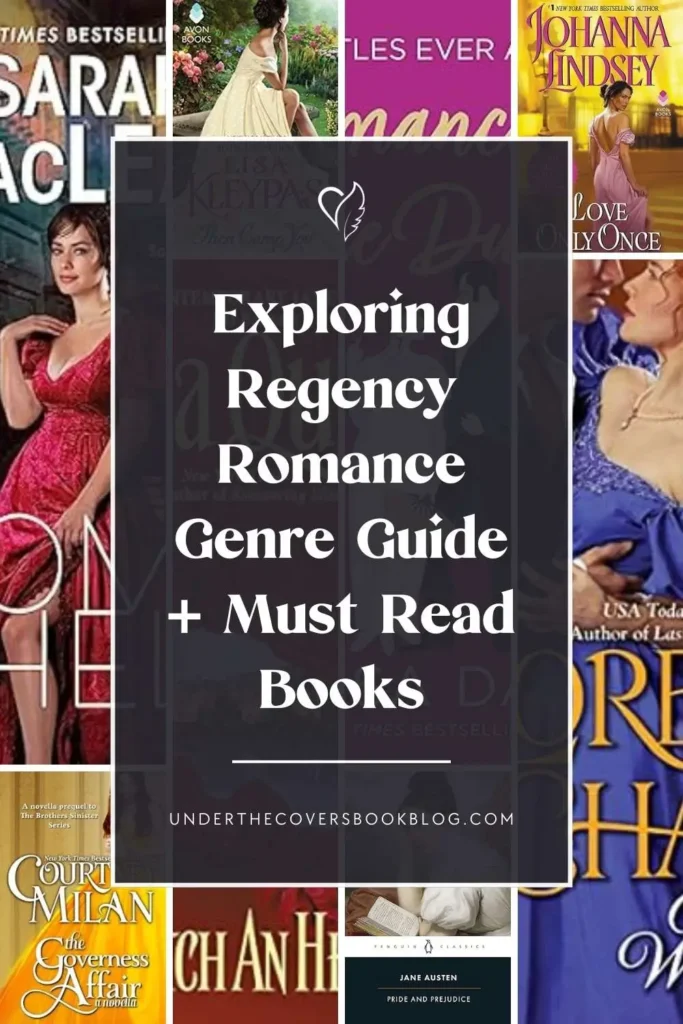
This post contains affiliate links. That means we receive a small commission at no cost to you from any purchases you make through these links.
Exploring Regency Romance: A Guide to the Era, the Books, and Why We Love It
The Regency era may have been brief, but its impact on historical romance is legendary. With dashing dukes, witty heroines, and enough societal drama to rival reality TV, it’s no wonder Regency romance continues to captivate readers. Whether you’re a longtime fan or just dipping your toes into the ton, let’s break down what makes this time period so irresistible.
What Was the Regency Era? (And Why Is It So Popular?)
The Regency period (1811-1820) might have been short, but its influence lingers. It was a time when Prince George IV ruled as Prince Regent in place of his father, King George III, who was deemed unfit to govern. The decade was defined by extravagance, rigid social rules, and scandalous liaisons behind closed doors—prime material for romance novels.
Why do we keep coming back to this era in fiction? Because it offers the perfect mix of structure and rebellion. The strict social hierarchy, elaborate balls, and intricate courtship rituals set the stage for tension-filled romances where every stolen glance and accidental brush of fingers means everything.
Why Regency Romance Feels Unique
Regency romances, much like the Regent himself, are charming and elegant, taking place in a sumptuous world of luxury—at least, for those in the right class of society. However, the era wasn’t as straitlaced as the Victorian period that followed, allowing for more intrigue and scandal in its storytelling.
One of the most defining aspects of Regency romance is its tone—some books lean toward lighthearted comedy and witty banter, while others delve into deep emotional turmoil and historical suspense. Interestingly, Regency settings often inspire spy romances more than their Victorian counterparts. The period’s political instability and Napoleonic wars make it an ideal backdrop for espionage, secret identities, and heroes or heroines leading double lives.
Common Tropes & Themes in Regency Romance
Regency romance novels explore themes of love defying societal expectations, balancing duty with desire, and the power of true love to overcome obstacles. Some of the most beloved tropes include:
- Class Disparity Romances – Love stories that bridge the gap between aristocracy and working-class characters, creating conflict over societal expectations.
- Spy Romances – Featuring spies, double agents, or secret government operatives entangled in love and danger.
- The Wallflower & The Rake – Shy, overlooked heroines capturing the attention of a notorious rogue, leading to fiery chemistry and transformation.
- Marriage of Convenience & Fake Engagements – Pretend relationships that become all too real.
- Forbidden Romances – Love between characters of different social standings or rival families, adding tension and urgency.
- Arranged Marriages – Exploring how partnerships built on duty can lead to genuine affection and love.

NEW TO HISTORICAL ROMANCE? Check out the Ultimate Guide to Historical Romance Books. We’ve got the 101 for you on what to expect when reading a historical romance, different time periods, settings, tropes, character types and more!
Settings & Atmosphere in Regency Romance
The setting is a crucial part of any Regency romance, creating a backdrop that reflects the era’s social hierarchy, rules, and the contrast between public appearances and private passions. Typical settings include:
- Grand country estates – Often the scene of house parties, stolen moments in libraries, and long carriage rides through picturesque landscapes.
- Elegant London townhouses – Perfect for hosting balls, secret midnight rendezvous, and sharp-tongued exchanges in drawing rooms.
- Opulent ballrooms – The ultimate setting for intrigue, jealousy, and first dances that change everything.
These locations serve as more than just scenery—they heighten the stakes of romance, adding both restrictions and opportunities for love to flourish.
Character Archetypes in Regency Romance
Regency romance thrives on recognizable character archetypes that embody the era’s ideals and contradictions. Some of the most popular include:
- The Brooding Duke – Wealthy, powerful, emotionally reserved. Often carrying past trauma, but utterly devoted once he falls in love.
- The Spirited Spinster – A woman past her “prime” (by Regency standards) who refuses to conform and instead finds a romance that defies expectations.
- The Rakish Viscount – Charming, irresistible, and scandalous—until he meets the one woman who makes him rethink everything.
- The Innocent Debutante – Thrown into society, navigating courtship with wide-eyed wonder and often a rebellious streak.
- The Spy or Soldier – Often hardened by war, these heroes bring action and intrigue to the romance while struggling to open their hearts.
- The Wallflower with a Secret – A seemingly shy, overlooked heroine who is much more than she appears, whether she’s hiding intelligence, wit, or a secret identity.
These archetypes not only make Regency romance compelling but also allow for fresh spins and modern takes on classic character dynamics.
The Influence of Jane Austen
Jane Austen’s influence on Regency romance cannot be overstated. Writing in a time when women had few rights and even fewer career opportunities, Austen defied societal expectations by becoming one of the most celebrated authors of all time. Her novels captured the constraints of her era while also offering a subtle critique of its rigid class structures and gender roles. Want to dive deeper? Check out our Jane Austen guide, including the best TV/movie adaptations.
Unlike the glamorous settings of many modern Regency romances, Austen’s stories were deeply rooted in the reality of her time. Her heroines navigated limited marriage prospects, financial instability, and social pressures with intelligence and wit. She infused her romances with sharp social commentary, proving that love stories could also be thought-provoking.
Despite her enduring legacy, Austen herself faced significant struggles. She published her works anonymously, as women writers were often dismissed or ignored. Financial security was always uncertain, and she remained unmarried, which was unusual for a woman of her class. Yet, through characters like Elizabeth Bennet and Anne Elliot, she gave generations of readers heroines who challenged conventions and pursued love on their own terms.
- Pride and Prejudice by Jane Austen – The blueprint for so many beloved Regency romances. If you love slow-burn tension and razor-sharp dialogue, this one’s for you.

Want to explore the authors who shaped Regency romance and the best books to start with? Check out the pioneers of the genre and our top 10 must-read Regency romances.
Iconic Regency Romances
- The Duke and I by Julia Quinn – The book that launched Bridgerton into the stratosphere. Fake courtship, a charming yet broody duke, and plenty of swoon-worthy moments.
- Nine Rules to Break When Romancing a Rake by Sarah MacLean – A heroine who’s done with society’s expectations? Yes, please.
- The Duke of Shadows by Meredith Duran – A deeply emotional and beautifully written romance featuring a strong-willed heroine and a tortured hero navigating love and survival across different cultures and conflicts.
- A Week to Be Wicked by Tessa Dare – A delightfully fun take on the marriage-of-convenience trope with a smart, unconventional heroine.
Why Regency Romance Still Feels Fresh
The Regency romance genre has also evolved to be more inclusive, with authors bringing fresh perspectives and diverse narratives that break away from traditional tropes. Stories featuring protagonists of different racial and cultural backgrounds, LGBTQ+ characters, and heroines who defy period norms make the genre feel more relevant than ever. Authors like Vanessa Riley, Amalie Howard, and Cat Sebastian are paving the way for Regency romances that reflect a broader range of experiences.
Looking for diverse Regency romances? Here are a few standout reads:
- An Earl, the Girl, and a Toddler by Vanessa Riley – A historical romance featuring a neurodivergent heroine and a hero navigating the complexities of race and society in Regency England.
- The Queer Principles of Kit Webb by Cat Sebastian – A delightful queer Regency romance featuring a reluctant highwayman and a nobleman caught in a high-stakes heist.
Despite being set over 200 years ago, Regency romances still resonate. The themes—societal expectations, forbidden love, personal freedom—are timeless. Plus, modern authors are bringing fresh perspectives by diversifying the characters and narratives within the genre.
Today’s Regency romances feature heroines who challenge societal norms, heroes who evolve beyond the typical brooding duke, and stories that highlight diverse identities and experiences, making the genre feel more relevant than ever.
Ready to Dive Into Regency Romance?
Regency romance isn’t just about the past—it’s about timeless love stories that continue to sweep us off our feet. Have a favorite Regency romance novel? Share it in the comments!
And if you want even more book recommendations, check out the posts below:
- Historical Romance Ultimate Genre Guide
- The Best Historical Romances You Have to Read
- Historical Romances to Make You Smile
- Badass Women in History
Originally posted March 4, 2024 | Last updated February 25, 2025
Pin It for Later


Join the Under the Covers Community
- Book Release Calendar
- Book Tropes Book Database
- Reading Under the Covers: Extra Bite – Exclusive Bonus Podcast Feed
- Additional recommendation lists
- Reading wrap-ups and our Bookish Brunch weekly behind the scenes newsletter
- Free downloads (activities, templates and more)
- And much more!

I can never keep the time periods straight.
Lady Darby series by Anna Lee Huber is one of my favorites, the story takes place in 1830.
Gaelen foley, jillian hunter, julia quinn and of course pride and prejudice
My favorite historical romance period!
Many of my favorite authors write in this era. I love all the eras that English romance are written with not really a favorite. Thanks for the wonderful explanation of the Regency period.
Great post, thanks Suzanne!
Wow, great article on the Regency background and some good book suggestions beyond Jane Austen.